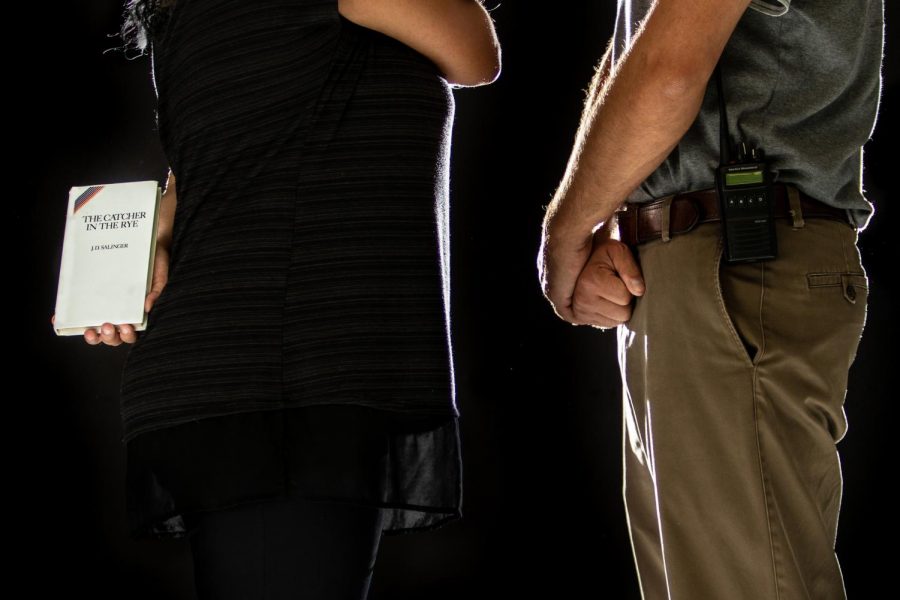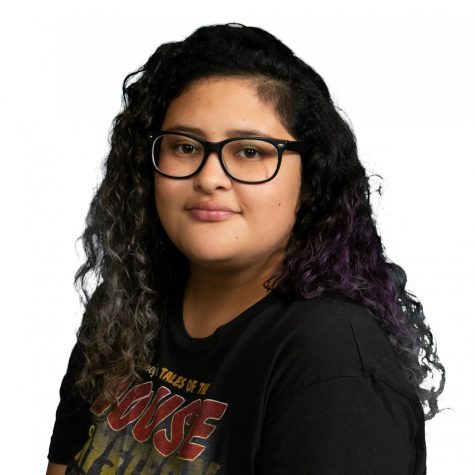A barrier of words
Banning creative literature
Photo by Oren Smith
September 25, 2019
Banned for its use of witchcraft. Banned for its use of violence. Banned for its use of vulgar language. There are thousands of books all over the world that contain subjects that are deemed controversial to many people, but those same books can teach students some of the greatest lessons they could ever learn.
“Nothing is bad, unless you have a negative mentality and classify it as negative. To me, the whole Harry Potter topic is like a bad word,” junior Ana Zepeda said. “You can say the f-word anywhere if you don’t consider it bad, and if you don’t treat it as a bad word, it doesn’t necessarily have to be bad.”
The books that students read and the books that people allow students to read can have a great impact on how a person looks at different situations throughout their life. Books have different lessons that can be learned through reading, yet there seems to be a lot of controversy on why students should and should not read some of these novels. The schools banned book display will be set up in the library this week.
“To Kill a Mockingbird” by Harper Lee
The book “To Kill a Mockingbird”, by Harper Lee, was banned because vulgar language, racial slurs, racial injustice, racism, gender roles, violence, mention of rape and loss of innocence.
The book follows a white man by the name of Atticus Finch, who is a lawyer during the time of the Great Depression, is sent to court to defend Tom Robinson, a black man accused of raping a young white girl. The Lee’s use of racial slurs and racial injustice has brought the book negative attention over the course of time with people not wanting their children reading it, because they worry about how they are going to feel when reading it.
“I think literature is the way in which when you look at something, and improve upon our society,” Badgett said. “And I think in To Kill a Mockingbird, you know, the goal that the author is trying to reach is to have an individual look at things from other people’s perspectives.”
“The Hate U Give” by Angie Thomas
Written in 2017 by Angie Thomas, “The Hate U Give” tells the story about 16 year old Starr Carter who lives two different lives: the poor neighborhood she lives in and the fancy prep school she attends. As she attempts to manage both sides of her life, Starr witnesses her childhood friend getting shot by a cop. Her friend was unarmed. Starr must make a desicion about what she wants to say and what she needs to say about the murder, but with all eyes on her, its difficult for her to talk about what happend that night. This book was banned for its mention of drug use, profanity, offensive language, racism and police brutality.
“The same context about like people from different racial or ethnic backgrounds being treated differently just because of the color of their skin and just because of the typical stereotype that they have,” Zepeda said. “ And I don’t feel like it should be banned because it is something that happens in real life.”
“Of Mice & Men” by John Steinbeck
By author John Steinbeck, “Of Mice and Men” tells the story of two immigrant field workers, George Milton and Lennie Small, as they move around California in search of a job opportunity during the time of the Great Depression. George is uneducated, but the smart one of the two while Lennie is a strong and bulky man who is mentally disabled. It became controversial because of its use of offensive language, morbid and depressing thoughts, racial slurs, and the mention of mental disability.
“I think that Steinbeck uses the language that he does in “Of Mice and Men” to lend authenticity and an honest to the book,” Badgett said. “You’re looking at grown adult men who are in a in a work type environment and the language in which they use is relevant to the situation in which they find themselves.”
“Harry Potter” series by J.K. Rowling
With the first book written in 1997 and the last book written in 2007, author J.K. Rowling tells the story of a young boy by the name of Harry Potter who is told that he is a wizard. He soon finds out that he has been accepted into a school of witchcraft and wizardry, and as he begins his journey in a new school he begins to build new friendships and finds new enemies. He learns about the dark past of his parents and learns that there is greater evil outside of the walls of his new school. All while learning what it means to be a leader and take risks for the people that he cares about. The book series was labeled as controversial for its dangerous ideas and attitudes, it promotes witchcraft, sets bad examples, it’s too dark, glorifies magic and the occult.
“It doesn’t necessarily have to be bad. For example, in the Harry Potter like collection, it literally, never crossed my mind, like once a negative thought, or like bad encouragement,” Zepeda said.
“Catcher in the Rye” by J.D. Salinger
Written in 1951 by J.D. Salinger,the story is told in the span of three days as it follows the life of 16 year old Holden Caulfield when he decides to leave his prep school in Pennsylvania and take a trip to New York. Holden decides that his prep school is full of phony people and goes to New York in search of the truth and of an escape from the phony students and teachers in his school. This book was banned because of its refrences to prostitution, primartial sex, sexual refences, vulgar language, violence and the mention of underage drinking.
“I think censorship is always a very slippery slope. And I really think that anytime we talk about banning something in particular,” Badgett said. “There needs to be a conversation had about why and what the issue is that’s going on. And I think a lot of times, the issue is something that a lot larger than the printed text.”
Books can impact people differently and banned novel can have an affect on how students feel about different topics. The stories that are told all over the world can change a person’s mentality on different subjects. Keeping topics hidden because they are too controversial is not always the best decision, but sometimes students are not ready to face serious problems. How we choose to approach the issue can have an even larger impact on how students react to books being banned.
“The fact that there are different types of ways for society to cope or society to run. And I feel like while it is fiction it could be something to look forward to,” Zepeda said. “But they have a different mentality, a different mindset that they follow through with. And I don’t think that it should be banned because it doesn’t like when I read it, it didn’t inspire, like rebellion, or inspired, deadly thoughts or anything like that.”















